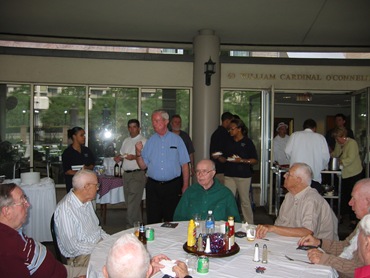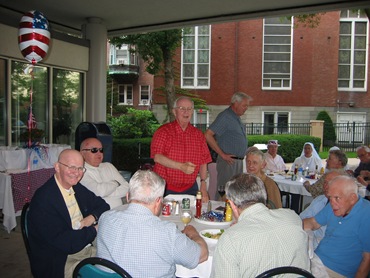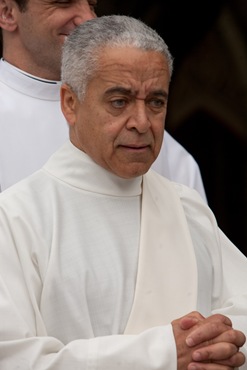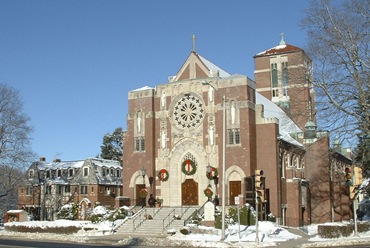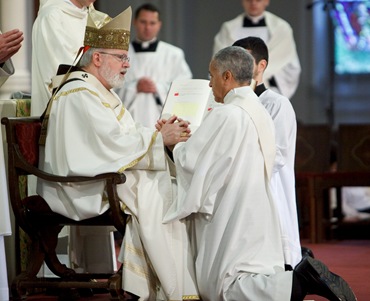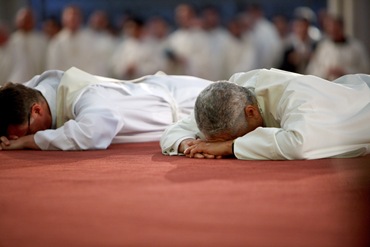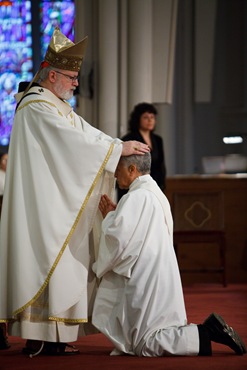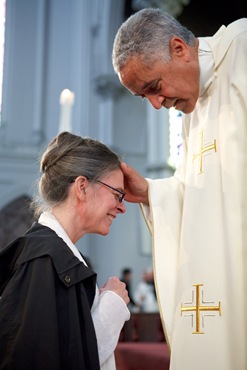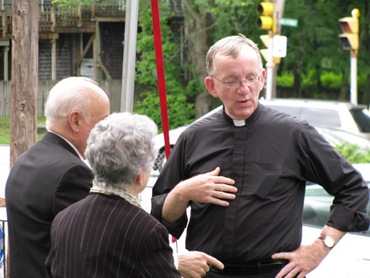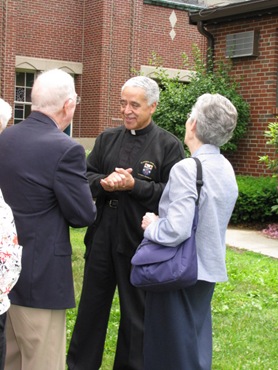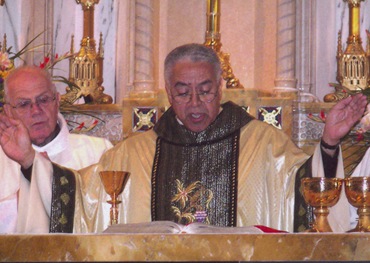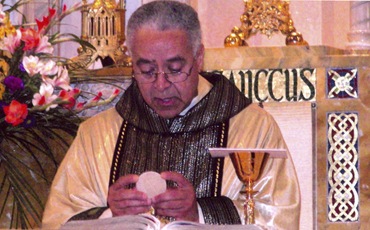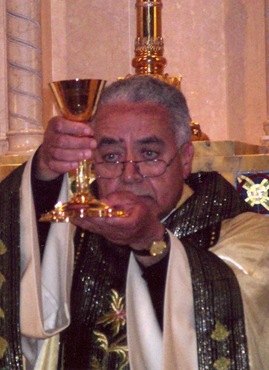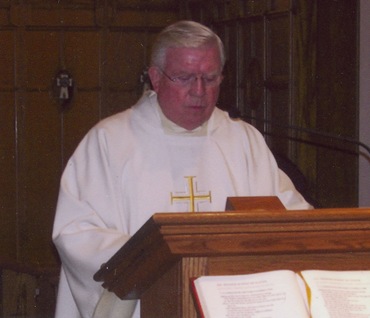As I did last week, I am sharing this week’s post with one of our newly ordained priests, Father Frank Campo, who was assigned to St. Mary Parish in Franklin.
But before I leave you with Father Campo’s account of his first experiences as a priest in Franklin, I want to share with you the following photos I just received from the Regina Cleri’s 4th of July picninc.
I was told it was a great success under the direction of Stephen Gust, the newly named Interim Director of Regina Cleri and Father James McCune, recently named chaplain for the retired priests of the Archdiocese and the priests living at Regina Cleri.
Looking at the cake below and the community spirit that was evident among the residents and guests, I regret not having been there, but unfortunately I was out of town at the time.
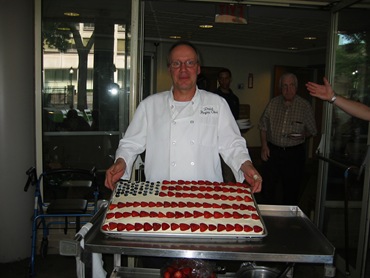
Cook David Oliva made a homemade cake
in the design of the American flag.
Now, as promised, I leave you with Father Campos’s remarks:
The day of Father Campo’s ordination to the priesthood
– – –
Since I arrived at St. Mary’s in Franklin a little over a month ago as the new parochial vicar and indeed as a new priest, the church and town have captivated me.
The late Giaconda “Jackie” Cataldo used to say there is no better place to live than Franklin and there is no better church anywhere than St. Mary’s, save for St. Peter’s in Rome. Originally a native of Italy, Jackie became one of the matriarchs of Franklin. She was certainly a very convincing lady.
Any new priest has a certain amount of anxiety about his first assignment. On Memorial Day, as I drove down Main Street which forms a promenade to St. Mary’s, a calmness overcame me as I was struck by the commanding view of the church.
At the same moment, I noticed a prominent shrine to St. Therese of Lisieux on the left front lawn of the church. St. Therese, the Little Flower, has long been my patron saint. She is also the patron of my 2009 class from Blessed John XXIII Seminary in Weston. Thus, I knew instantly Therese was taking charge.
A few moments later, I sat with Father Brian Manning, the new St. Mary’s pastor, yet a seasoned pastor of considerable wit, compatibility, and experience. After that, my new priest anxiety was mostly gone.
Giving God’s Blessing after the ordination
It disappeared entirely when I met the St. Mary’s parishioners and staff, who form a true parish family: active, committed, faithful to the Church’s liturgy, welcoming, emanating Christian graciousness and joy at its finest. Whether it be a delicious dish of trippa (tripe) or ricotta pie arriving at the parish, or an array of other kind gestures, Jackie Caltado’s observation that Franklin is a gem of a town and St. Mary’s a jewel of a Church becomes more and more convincing.
Father Brian Manning, Pastor, with parishioners Donald and Betty Ranieri
St. Mary’s, one of the busiest parishes in the Archdiocese, has the full and undivided attention of Father Brian and myself. We regret not having been able to meet long-time parishioners such as Jackie Cataldo before they were called home by the Lord. However, we have been able to preach at their funerals and have to come to know them in a special way, through the light of eternity.
Speaking with Ed and Joan Cannon, parents of two other Boston priests, Fathers Richard and Ken Cannon
The joy of administering the sacraments — especially as a new priest — creates a sort of unreality which is, in actuality, the greatest of realities. Baptisms, weddings, reconciliation, anointing, as well as funerals, visiting hospitals, nursing homes, private homes, attending civic events and ecumenical gatherings are Father Brian’s and my overall service to the parish of St. Mary’s. Above all, of course, is the celebration of the Holy Sacrifice of the Mass, which leaves one in wordless wonderment. As a new priest, I feel that the Lord is truly spoiling me by giving me the gift of the priesthood.
Celebrating my first Mass at St. Bridget in Framingham
One of the questions that parishioners ask me is what seminary course, in particular, has had the most influence in me. I respond that all the courses at Blessed John XXIII are influential; however, liturgical singing is particularly striking to me and immediately relevant. As 4th year seminarians we were taught how to sing various parts of the Mass in an impeccable liturgical manner. Msgr. Francis Strahan, a consummate pastor and musician of St. Bridget’s in Framingham, teaches the course. It is putting into practice St. Augustine’s famous saying, “Those who sing, pray twice.” The parishioners have kindly voiced their approval of my humble attempts to sing the sacred melody, the various acclamations, prefaces and the like of the Mass, even the highest prayer of praise and sacrifice, the words of the consecration.
Meanwhile, the 31th anniversary of St Rocco’s “festa” is fast approaching! Franklin is all aglow from August 13-16, the high-water mark of the festival. The opening Mass is on the 9th. It is well-known that any trip to Italy should be postponed for those days, for Italy comes to Franklin during the festival.
St. Rocco, the 13th century saint and miracle worker who spared Italy from the worst ravages of the plague then rampant throughout Europe, is given due honor sacramentally and in festive celebrations. The Italian food, cooked to a degree of perfection during the St. Rocco’s Festival, is famous not only in the Archdiocese of Boston, but also in the adjoining dioceses of Worcester and Fall River.
Msgr. Strahan delivered the homily at my First Mass
The festivities are held on the grounds of the old convent of Bernadine nuns, and later the St. Joseph nuns, who served Franklin for so long, so lovingly, and so well. It all takes place a very short distance from the great St. Mary’s itself in the great town of Franklin.
Jackie Cataldo, the best publicist of church and town, was indeed a very convincing lady.
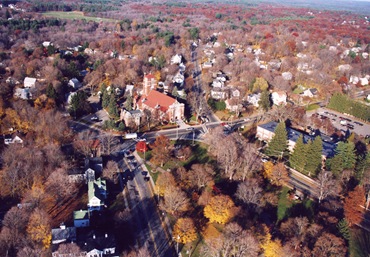 An aerial view of
An aerial view of
“the great St. Mary’s in the great town of Franklin”
– – –
Next week we will resume our regular postings, so stay tuned.
In Christ,
Cardinal Seán

